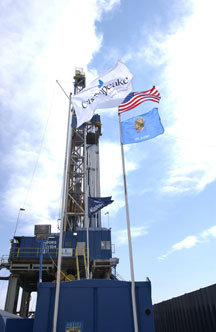Chesapeake Energy’s anticipated divestiture of as much as $5 billion in Permian Basin assets is not likely to soften the local market, observers say.
The flurry of news reports detailing the financial stresses of Chesapeake  Energy, cropping up in mid-May, brought with them the disclosure that the Oklahoma City-based firm is looking to find buyers for as much as $5 billion in Permian Basin assets. The prospective sale activity could involve more than 1.5 million acres in leases.
Energy, cropping up in mid-May, brought with them the disclosure that the Oklahoma City-based firm is looking to find buyers for as much as $5 billion in Permian Basin assets. The prospective sale activity could involve more than 1.5 million acres in leases.
Chesapeake, which has been an aggressive operator in the shale gas field, has suffered from tumbling gas prices and now must shore up its finances and reduce its debt by selling properties.
To determine how such a strategy might impact the local energy marketplace, PBOG called upon some industry observers for their views.
Mickey Cargile, managing partner at Cargile Investments, at Western National Bank, has seen this sort of thing before.
“Our area really has been a kind of laboratory for large companies divesting themselves of assets into smaller hands,” Cargile said. “And that’s been a boost for the local economy. If you sell to smaller local operators, it becomes a boost for them because they have more incentive and can pay more attention to developing the prospects in a more efficient way than can the larger entities. With a smaller operator, a project takes on a more important status.”
Cargile said he believed that principle was true not just in the oil and gas world, but in all aspects of business. “The smaller the operation, the better it is for the economy.”
He admitted that he was not familiar with the properties that Chesapeake might be offering, but that he knew the company’s holdings are considerable. “They are huge players in the Barnett Shale,” he said. “And as I recall, this isn’t the first time they have divested property out here to meet their needs for money.”
Cargile said he would expect, from the nature of what Chesapeake is going, that buyers are going to be able to buy properties at an economically feasible price. “Independent oil and gas producers do not overpay for properties,” he said. “Our local people who are involved in that industry—if they buy, they will buy at a price that is feasible.”
Asked how prices have held up locally, Cargile observed that prices for gas-producing properties are down, but that is simply because the price for gas is low. So if they are selling gas properties, then I expect it would be a buyer’s market.
Overall, though, the future for energy is bright, he said. “Particularly in our area. I do think that because of the strengthening dollar, we will continue to see oil prices come down over the short term, but if they come down into the $80 or $85 range, for WTI [West Texas Intermediate Crude] then I would want to become a buyer.”
At Community National Bank of Midland, Rick Mitchell, vice president of energy lending, observed that such a large deal as Chesapeake represents would be beyond the scope of many of his customers, unless the deal were broken into packages or parcels. Just the same, though, if the transactions are made, the deal(s) can have a trickle-down effect on his bank’s customers, whether they participate or not.
He mentioned the numerous service companies who are customers at his bank. “We’re trying to keep an eye on things there, if they happen to be businesses who are working for Chesapeake. We’re hoping they are staying busy with other customers as well.”
As for the anticipated divestiture itself, Mitchell said that when he heard about it, he was surprised at the idea of it at first. “It seemed kind of crazy, because that’s a liquids-rich play they are in, where prices are good, and that’s especially interesting if you are a company like Chesapeake that is heavy in dry gas. But when you think about it further, it does make sense to sell those assets that would be in a hot area, a hot play, and get it done while they can get a premium for those assets.”
Byron Tuck, manager of business devel for Simon Associates, a company that brokers deals in the oil and gas industry, thinks that the Chesapeake offerings will be received very well by the marketplace.
“They [Chesapeake] will find buyers for it,” he said. “The Permian Basin properties are very popular right now. Several companies are looking at their [Chesapeake’s] divestiture packages, and it might turn out that their [Chesapeake’s] timing is very good, even though this is a ‘forced’ sale.”
Tuck said he sees parallels in other deals that went well, such as BHP Billiton’s purchase of Petrohawk in 2011 and the deal in which Exxon, in the Delaware Basin, brought in a Russian company as a partner. The sale of Parallel Petroleum to a Korean company earlier this year is another example. “We’re going to see a lot more money coming into the Permian Basin,” he said. “Primarily because it is oil and not gas. Capital is still plentiful. We’ll see more and more interest, including foreign money. They can come in here and buy not just the leases but everything else—the staff, infrastructure, everything.”
Tuck said he did not think the selloff would hurt the local market. “We won’t suffer a loss by Chesapeake selling out. It could be plus, for the buyer as well as the seller. Chesapeake’s divestiture could just be a redeployment of assets. We’re not going to lose that expertise.”









